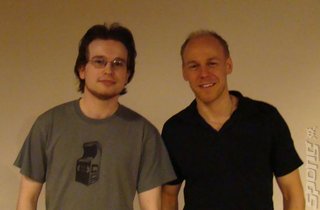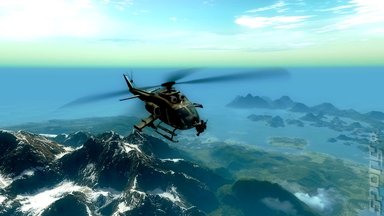When you give a gamer the means to take out an entire fictional country (while, you know, removing a nasty dictator from office, if you have time), in a sandbox-type scenario with plenty of missions to sink their teeth into, you know you have a recipe for success. (The original)Just Cause provided a more-than-satisfying amount of refreshing jungle destruction and earned itself many admirers in the process. At an event with Eidos in London showcasing the upcoming sequel, the return of Rico Rodriguez starts to sound very exciting indeed.
That’s due in part to the sheer mass of improvements made to the engine – not resting on its laurels, developer Avalanche has re-coded the entire game, given the main character all new animations and combat systems and added sweet weather effects that change dynamically as you cross into different terrain. Grappling with cars and flying across bridges in an on-demand parachute, while inadvertently causing a pile-up, all adds to the game’s renewed philosophy of ‘chaos motivation’.
Sounds intense, eh? Following a presentation in which Rico proceeded to blow up petrol stations, cross deserts and rescue secret agents in snowy mountains (while having to face ninjas – ninjas!) I caught up with lead designer Peter Johansson so that he could explain more about the enhancements that have been made Just Cause 2. Here's the first part:
SPOnG: First off, could we get a quick history of your time in the games industry?
Peter Johansson: I joined Avalanche sometime towards the end of development of Just Cause. I started work on Just Cause 2 as soon as I walked in, actually. My task was looking at things that needed to be improved from the original, and deciding on the direction we wanted to take the sequel. So work on Just Cause 2 began before we even finished the first one.
Before Avalanche I worked for Amuze – we worked on the Headhunter games; I was the lead designer for those. We worked on other stuff at Amuze, but then the studio shut down, which led me to move onto Avalanche.
SPOnG: How did you go about finding things to improve for Just Cause 2? Although Just Cause was incredibly fun, there were also some incredibly fun glitches too. So how did you approach that? Did you get feedback from players or find things out yourselves?
Peter Johansson: Of course, some of the stuff we improved or added was stuff that we wanted to put in Just Cause and didn’t have the time to implement, but some things were based on people’s reactions as well. So I think there was a little bit of input from all of those things. The core areas that we identified quite early on were the size of the world, making sure there is meaningful content around the map, and making the experience a lot less linear.
In Just Cause, the level progression was more ‘go from here, to there, then here and back there again’ and when you had all this space to explore it didn’t really provide as much freedom to tackle the missions, so that was something we’ve improved.
We’ve also paid more attention to the stunts in the game – we wanted to make the grappling hook and parachute a real part of Rico as a character, so we’ve tightly integrated them into everything he does. He can use a combination of the two to get around places, as a method of combat and as a part of the missions you play as well. There are situations for the player where you can make use of the base-jumping and stuff like that.
And of course, we focused more on the combat to make it that much more challenging and tactical. I’d say those were the areas we worked on the most, and a lot of that had to do with our experiences from Just Cause. The original was a game that had so much potential, and the reason the sequel exists is because there was so much we wanted to add.
We actually ended up doing a lot of the engine and coding from scratch though (laughs)! Because we really didn’t want the game to seem like a mere expansion to Just Cause.
SPOnG: Let’s talk about the technology behind the game now, because Just Cause 2 is using the Avalanche 2.0 engine. In terms of technical accomplishment, what does this add to the game’s experience?
Peter Johansson: It adds a lot of things, the Avalanche 2.0 engine is the result of multiple tweaks and fixes that we discovered during play of Just Cause, and we’ve been constantly maintaining the code since the game was finished. A lot of the new features in that engine helped influence the direction of Just Cause 2 – so the new climate zones allowed us to be a bit more creative with the areas you can go and the weather effects, for example.
We also wanted more dynamic objects and to add more destructibility into the game as well, because that sits well with the sorts of situations you can find yourself in. There’s a lot more detail in the game world and the characters. I mean, Rico’s animation system has been completely re-done, so we have had many different layers of animation to recreate. When Rico’s running through jungles, you have small leaves moving around, he’s influenced by slopes in the ground, and that makes his character much more alive.
So there are a lot of graphical and technical enhancements across the board, even in the small things… there are so many passionate people in the Avalanche offices that you can come to work one morning and find that someone’s added some graphical effect on a bridge or something in their spare time. It really makes a lot of difference in the end when you have a lot of these sort of things implemented.
We’ve just increased the terrain resolution too – the amount of polygons in the ground is about four times that in the Xbox 360 version of Just Cause.
End of Part 1
Check back soon for more...
That’s due in part to the sheer mass of improvements made to the engine – not resting on its laurels, developer Avalanche has re-coded the entire game, given the main character all new animations and combat systems and added sweet weather effects that change dynamically as you cross into different terrain. Grappling with cars and flying across bridges in an on-demand parachute, while inadvertently causing a pile-up, all adds to the game’s renewed philosophy of ‘chaos motivation’.
Sounds intense, eh? Following a presentation in which Rico proceeded to blow up petrol stations, cross deserts and rescue secret agents in snowy mountains (while having to face ninjas – ninjas!) I caught up with lead designer Peter Johansson so that he could explain more about the enhancements that have been made Just Cause 2. Here's the first part:
SPOnG: First off, could we get a quick history of your time in the games industry?
Peter Johansson: I joined Avalanche sometime towards the end of development of Just Cause. I started work on Just Cause 2 as soon as I walked in, actually. My task was looking at things that needed to be improved from the original, and deciding on the direction we wanted to take the sequel. So work on Just Cause 2 began before we even finished the first one.
Before Avalanche I worked for Amuze – we worked on the Headhunter games; I was the lead designer for those. We worked on other stuff at Amuze, but then the studio shut down, which led me to move onto Avalanche.
SPOnG: How did you go about finding things to improve for Just Cause 2? Although Just Cause was incredibly fun, there were also some incredibly fun glitches too. So how did you approach that? Did you get feedback from players or find things out yourselves?
Peter Johansson: Of course, some of the stuff we improved or added was stuff that we wanted to put in Just Cause and didn’t have the time to implement, but some things were based on people’s reactions as well. So I think there was a little bit of input from all of those things. The core areas that we identified quite early on were the size of the world, making sure there is meaningful content around the map, and making the experience a lot less linear.
In Just Cause, the level progression was more ‘go from here, to there, then here and back there again’ and when you had all this space to explore it didn’t really provide as much freedom to tackle the missions, so that was something we’ve improved.
We’ve also paid more attention to the stunts in the game – we wanted to make the grappling hook and parachute a real part of Rico as a character, so we’ve tightly integrated them into everything he does. He can use a combination of the two to get around places, as a method of combat and as a part of the missions you play as well. There are situations for the player where you can make use of the base-jumping and stuff like that.
And of course, we focused more on the combat to make it that much more challenging and tactical. I’d say those were the areas we worked on the most, and a lot of that had to do with our experiences from Just Cause. The original was a game that had so much potential, and the reason the sequel exists is because there was so much we wanted to add.
We actually ended up doing a lot of the engine and coding from scratch though (laughs)! Because we really didn’t want the game to seem like a mere expansion to Just Cause.
SPOnG: Let’s talk about the technology behind the game now, because Just Cause 2 is using the Avalanche 2.0 engine. In terms of technical accomplishment, what does this add to the game’s experience?
Peter Johansson: It adds a lot of things, the Avalanche 2.0 engine is the result of multiple tweaks and fixes that we discovered during play of Just Cause, and we’ve been constantly maintaining the code since the game was finished. A lot of the new features in that engine helped influence the direction of Just Cause 2 – so the new climate zones allowed us to be a bit more creative with the areas you can go and the weather effects, for example.
We also wanted more dynamic objects and to add more destructibility into the game as well, because that sits well with the sorts of situations you can find yourself in. There’s a lot more detail in the game world and the characters. I mean, Rico’s animation system has been completely re-done, so we have had many different layers of animation to recreate. When Rico’s running through jungles, you have small leaves moving around, he’s influenced by slopes in the ground, and that makes his character much more alive.
So there are a lot of graphical and technical enhancements across the board, even in the small things… there are so many passionate people in the Avalanche offices that you can come to work one morning and find that someone’s added some graphical effect on a bridge or something in their spare time. It really makes a lot of difference in the end when you have a lot of these sort of things implemented.
We’ve just increased the terrain resolution too – the amount of polygons in the ground is about four times that in the Xbox 360 version of Just Cause.
End of Part 1
Check back soon for more...







